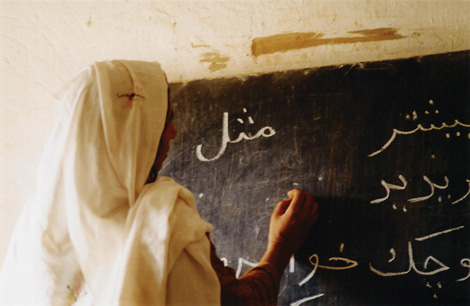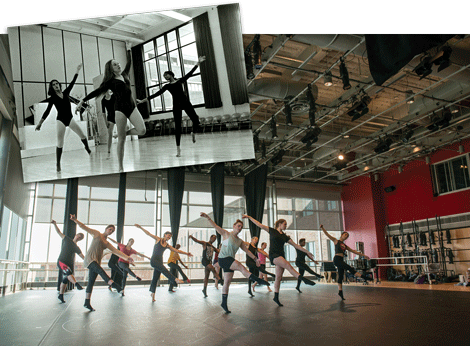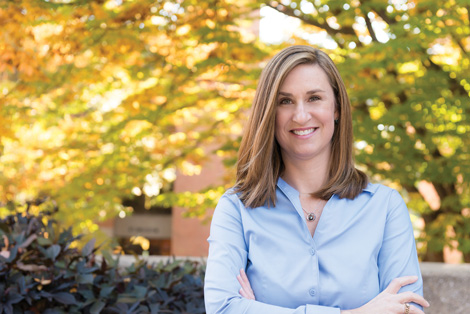INSPIRED CHOICE
Julia M. Ross’ path to becoming the new dean of UMBC’s College of Engineering and Information Technology (COEIT) was paved by numerous achievements as a scholar and an academic leader. But it is a deep commitment to breaking down disciplinary boundaries, ensuring graduate student success, and increasing diversity in the fields encompassed by her college that have characterized her time at UMBC.
Ross arrived at the university in 1995, rising eventually to become Constellation Professor of Information Technology and Engineering at UMBC. In 2011, under her leadership as chair, UMBC’s chemical and biochemical engineering department merged with the civil and environmental engineering department to create a single entity. (Ross remains a professor in the new chemical, biochemical, and environmental engineering department.)
The new dean has a stellar record of scholarship in bioengineering and engineering education, and is the author or co-author of more than 50 peer-reviewed publications. In 2013, Ross received a prestigious American Council on Education fellowship, which is the nation’s premier higher education leadership development program. During that year, Ross worked with Jay Perman, president of the University of Maryland, Baltimore.
At UMBC, Ross also served as special assistant to the provost for inter-institutional research initiatives and was instrumental in enhancing research relationships and collaborations between UMBC and the University of Maryland, Baltimore, including the development of the universities’ joint seed grant program.
Another initiative that Ross has helped spearhead is the INSPIRES Curriculum – a program for high school students supported by the National Science Foundation and designed to promote interdisciplinary research in science and engineering education. The program’s acronym stands for “INcreasing Student Participation, Interest and Recruitment in Engineering and Science,” and the research team led by Ross began its work by building a curriculum that could be used in high school classrooms to teach engineering.
“We were trying to put something together that could be used by all students,” says Ross. “We’ve developed an engineering curriculum that is well suited for putting into science and technology classes. There are very few curricula for either that incorporate engineering. We were trying to develop something that was low cost and modular but still had real engineering in it.”
Ross and her colleagues recently received $3 million from the NSF to continue their work, and she believes the timing couldn’t be better. “Science standards have changed,” Ross observes, “and they now place engineering as part of the Next Generation Science Standards.”
“UMBC is very fortunate to have someone of Ross’s impressive experience and talent to serve as our next dean of the College of Engineering and Information Technology,” says Provost Philip Rous.
In her new role, Ross is seeking to attract top graduate students to the college. Yet she adds that her college also must focus on attracting and retaining just the sort of undergraduate students who may be inspired by the curriculum she has helped develop in high schools.
“We have to work to diversify the undergraduate population,” says Ross. “I’d love to see us exceeding the national average regarding minorities and women. And we also need to make sure that as students move through the college that they are progressing equally regardless of their backgrounds.”
– Nicole Ruediger
SAFER AND STRONGER
UMBC’s increasingly central role in strengthening our nation’s cybersecurity infrastructure – and its growing ability to collaborate with private industry in that effort – were highlighted in October by the announcement of the university’s participation in a new Federally Funded Research and Development Center (FFRDC).
The U.S. Commerce Department’s National Institute of Standards and Technology (NIST) – which promotes U.S. innovation and industrial competitiveness by advancing measurement science, standards and technology in ways that enhance economic security and improve national quality of life – awarded a contract to operate the new center to the MITRE Corporation.
The center is the first to be dedicated solely to enhancing cybersecurity and protecting national information systems. MITRE will partner with the University System of Maryland (USM) to carry out the center’s goals, with UMBC and the University of Maryland, College Park as the essential collaborators in that effort. The contract to operate the center has maximum funding of $5 billion over 25 years.
“Securing our cyber infrastructure requires government, industry, and higher education to work closely together, and this center makes that powerful collaboration possible,” says UMBC President Freeman A. Hrabowski, III. “Further, it solidifies Maryland’s role as the hub of cybersecurity in our nation.”
Anupam Joshi (photo, left), director of the UMBC Center for Cybersecurity, will serve in a leadership role for UMBC in the new project. Joshi says that “while national security interests are usually central to the security conversation, this center will also work to meet the cybersecurity needs of individuals and businesses in a variety of sectors, such as health care and energy. Individuals and small and medium-size businesses constitute a major part of the nation’s cyber-infrastructure, but can lack the resources and technical expertise to respond effectively to cyber threats.”
Geography – and the proximity of the USM and UMBC to a growing hub of activity in cybersecurity – also played a role in the award. The federal government sponsors fewer than 50 FFRDCs across the country, and all are designed to tackle complex, long-term problems of significant national interest. Maryland hosts a large number of federal agencies and companies on the cutting edge of cybersecurity, and the USM is nationally recognized for its research and education programs in the field.
U.S. Senator Barbara A. Mikulski lauds the public-private collaboration created by the new project. “This new center unites the knowledge of the government with the know-how of the private sector,” she observes, “to develop cyber technology solutions needed to protect dot-com entities and make our cyber-infrastructure more resilient.”
This new center will support the National Cybersecurity Center of Excellence (NCCoE), established in 2012 by NIST, the state of Maryland, and Montgomery County to help businesses secure their data and digital infrastructure by bringing together information security experts from industry, government, and academia. The collaboration between the USM and MITRE will further the NCCoE’s goal to foster public-private collaborations to identify and solve today’s most pressing cybersecurity challenges.
“I am delighted about this new strategic collaboration with our colleagues at College Park and at MITRE,” says Karl Steiner, Vice President for Research at UMBC. “It will provide opportunities to further expand and apply our scientific capabilities in an area of such critical importance.”
– Dinah Winnick
CONTEMPLATING COMMUNITY

When Anne E. Brodsky won a national award in February 2014 for contributions to the field of community psychology, it came as no surprise to her students and colleagues at UMBC. Brodsky is a tireless scholar who has nurtured dozens of graduate and undergraduate researchers – all while working in collaboration with a range of social-service organizations in Baltimore and beyond.
Over the last 20 years, Brodsky has made creative use of narrative and other qualitative methods in her field. She also conducted extraordinary field work in Pakistan and Afghanistan from 2001 through 2007, including the study of an underground feminist organization there at a pivotal moment in the region’s history.
Brodsky, a professor of psychology, joined UMBC’s faculty in 1997. Her research initially focused on resilience and community-building among East Baltimore women affected by welfare reform. In 2000, however, Brodsky’s work took an unexpected turn when she met members of the Revolutionary Association of the Women of Afghanistan (RAWA) – a feminist organization that has resisted the Soviet, Taliban, and post-Taliban regimes since 1977 – at a conference in Baltimore.
“This was an organization that had never been able to come to the West, never been able to share its stories,” Brodsky recalls. “We put together an informal national tour, and for four months, they were in and out of my house.”
One morning not long after the tour, Brodsky says, “I woke up and thought, wait: Risk. Resilience. Women’s communities. I do this for a living.” She sent her RAWA contacts an e-mail message and, to her surprise, they were willing to have an American academic visit their clandestine sites in Pakistan and Afghanistan.
Brodsky made her first visit in July and August of 2001, just weeks before the September 11 attacks, and returned for several more months in 2002. The resulting book, With All Our Strength: The Revolutionary Association of the Women of Afghanistan, was published by Routledge in 2003 and received strong reviews.
One major concept that Brodsky has attempted to formalize throughout her work is resilience – that is, the strengths that allow women to endure in contexts of risk and adversity. In both Afghanistan and East Baltimore, she and her colleagues have found, having children can serve as a protective factor, providing hope and motivation to persist even in extremely challenging climates.
Gitika Talwar, who is completing a doctorate in psychology at UMBC, is one of 13 past and present UMBC graduate students who have co-authored papers with Brodsky. “She has an amazing range of scholarly interests,” Talwar says. “I’m on the West Coast now studying Afghan immigrant communities, but we still make time every two or three weeks to talk about my research. She’s been very supportive the entire way.”
Brodsky is a former director of UMBC’s Gender and Women’s Studies program and is an associate dean of the College of Arts, Humanities and Social Sciences.
“Anne’s just top-notch,” says Kenneth Maton, a professor of psychology. “She asks really difficult and appropriate questions, and she brings to bear important theoretical perspectives. When she went to Afghanistan, that was an intellectual stretch and also a personal risk. But she’s always been determined to follow her intellectual passions.”
– David Glenn
STEPS TO THE FUTURE

Dance has been an integral part of the artistic and academic environment at UMBC since the university’s earliest days, and the completion of the second and final phase of university’s Performing Arts and Humanities Building (PAHB) is an opportunity for the entire community to reflect on the importance of the centrality of the arts in the UMBC experience.
The dance department at UMBC has long occupied a large and well-lit studio in the university’s Fine Arts Building. Over the years, thousands of UMBC students – be they dance majors or students who have woven the art into their academic life – have taken flight in that space.
The studio in Fine Arts that saw so much motion and energy over the last four decades is now in the process of an extensive remodeling and repurposing for other uses, but the new home for the dance department in the PAHB features a 120-seat dance studio and a separate dance technology studio.
The opening of the second phase of the PAHB – which was formally commemorated at a ceremony in October – concluded a transition that encompassed not only UMBC’s dance department, but also its music, philosophy and ancient studies departments. The new phase of the building also includes a 350-seat concert hall, a new rehearsal hall, a recording studio for the music department, and an archaeology lab that is central to the continuing teaching mission of UMBC’s ancient studies department.
– Richard Byrne
Tags: Fall 2014

